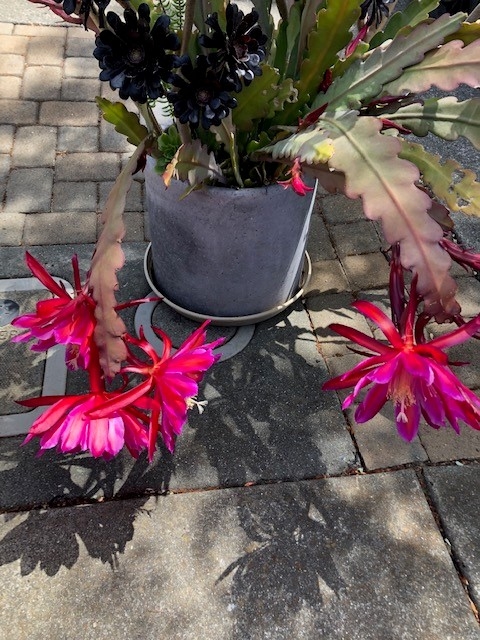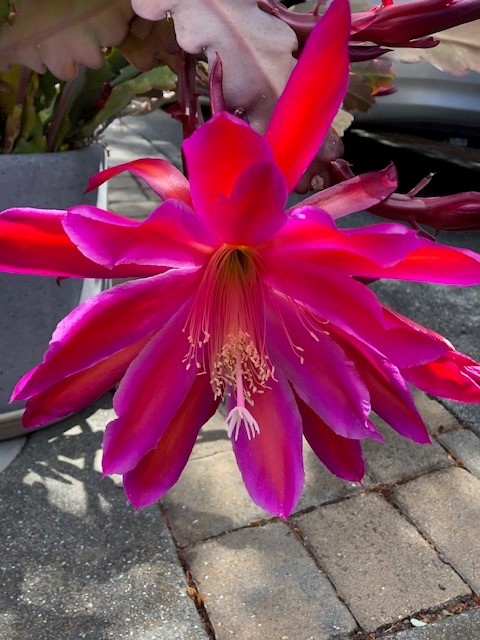Orchid Cactus: Epiphyllum and New Friends
One of the many benefits of gardening is a sense of beauty and wonder that the discovery of new and beautiful plants bestows on the observer. Since becoming a Master Gardener (first year), I have been more interested in the plants in my neighborhood, particularly the interesting plants that are popping up as avid collectors of succulents and cacti display their many specimens.
One such specimen caught my eye while admiring a neighbor's well-tended garden: a beautiful, upright, tall cactus-looking plant with some subtle red coloration that tinged its otherwise green stems. As a lover of cottage gardens with showy flowers, I had largely ignored cacti and succulents until recently. We paused during our dog walk and were admiring the plant, which filled a very large pot in the front of the neighbor's yard. The homeowner noticed that we were admiring it and approached us to tell us all about the plant. He is very knowledgeable about tropical plants as evidenced by his yard with real producing banana trees and other exotics. Imagine our surprise when he offered to take a cutting so we could grow our own. He described how to plant the cutting, care it would need, and then casually said, oh, and it grows really big flowers that last about 3 days. He warned us about the needle-like thorns that appear on the stems, and how gloves should be worn when handling the plant. We went home with a 12-inch stem and proceeded to pot it, and prop it up with a plant stake, and keep it in a corner window since it was winter and the winds could be fierce in our back yard. It almost immediately began growing and surprised me by growing another segment. I began to think it might actually survive, so I began the search for its name and care instructions.
After searching for the name of this cactus with the app Plant Snap, and looking at many false leads, I was able to narrow its name down to Epiphyllum, of which there are several varieties and hybrids. Once the flower appeared on my neighbor's plant it was much easier to identify the plant. I confirmed that the name is epiphyllum, commonly called Orchid Cactus. “Epi” means upon in New Latin or Greek, and phyllum means “stem”. The plant in question is an epiphyte, like orchids and bromeliads, and resembles a Christmas cactus on steroids. An epiphyte grows on the surface of other plants, obtaining its water from the moist air, rainfall, and from moisture in leafy debris where it resides on another plant. These plants are native to Central and South American rainforests and are quite popular the world over as houseplants.
General care of the “epi” is to plant it in light well-draining soil, and to provide filtered sun except for a few hours of direct morning sun. Epiphyllums prefer temperatures of 40-90° degrees F. in summer and should be protected in winter if temperatures drop below 32° F, or it will die off. Watering can be a balancing act. The top 1/3 of the soil should be kept damp but do not allow standing water at the roots to avoid fungus gnats and root rot.
For more information on caring for the cactus I found these websites helpful:
https://extension.oregonstate.edu/gardening/flowers-shrubs-trees/orchid-cactus-epiphyllums
https://www.gardeningknowhow.com/ornamental/cacti-succulents/epiphyllum/epiphyllum-plant-care.htm
Enthusiasts just call these plants “Epis”. The ease of making a new start from a cutting has given me more confidence about attempting to grow this interesting looking plant with lavish red-pink flowers that last only a couple of days, but are so worth it!
As a side note: during this time of social distancing and isolation due to the global pandemic, finding ways to connect with neighbors can really lift the spirits. The above encounter led to exchanging names, greeting each other more often, giving reports about the cuttings our neighbor has shared, and exchanging plant cuttings for fresh vegetables.

photos by Kathy Craig

epiphyllum close up kcraig 2020


The night blooming cereus opens late at night and only open that night.
It is the size of a 7 month old head
I would be willing to share cuttings with you
Posted by Gretchen Dougherty on August 30, 2020 at 8:38 AM